Don't delay SRM implementation: ASFA


The Association of Superannuation Funds of Australia (ASFA) says the Standard Risk Measure (SRM) should be implemented now before further changes to guidance are made.
ASFA said it was important the industry demonstrated to the regulators and Government that it was able to self-regulate.
The SRM is one of the mandatory requirements of the shorter product disclosure statements (SPDS) regime and a requirement of new SPDSs issued after 22 June 2012. It aims to facilitate the comparison of investment options.
Although ASFA conceded the measure was not perfect, it said it was better than nothing in the absence of an alternative.
Last week, the Actuaries Institute, the Australian Institute of Superannuation Trustees and the Industry Super Network co-authored a submission to the Australian Prudential Regulation Authority (APRA) expressing serious concerns about the SRM.
They said further consultation with industry was needed to ensure labelling was not misleading and a consistent approach to the SRM calculation methodology was implemented. The submission also said the SRM needed enhanced investment risk measures.
"Annual volatility may not be the best general risk measure for superannuation - a retirement savings vehicle with a legislated long-term investment horizon," it said.
ASFA has requested feedback from members to address concerns and ensure understanding of the measure prior to a pending review.
Although there is no timeframe for the review, ASFA said it was important to implement the SRM now.
The SRM was released by ASFA and the FSC in August last year.
Recommended for you
Governor Bullock took a more hawkish stance on Tuesday, raising concerns over Trump’s escalating tariffs, which sent economists in different directions with their predictions.
Equity Trustees has announced the appointment of Jocelyn Furlan to the Superannuation Limited (ETSL) and HTFS Nominees Pty Ltd (HTFS) boards, which have oversight of one of the companies’ fastest growing trustee services.
Following growing criticism of the superannuation industry’s influence on capital markets and its increasing exposure to private assets, as well as regulators’ concerns about potential risks to financial stability, ASFA has released new research pushing back on these narratives.
A US-based infrastructure specialist has welcomed the $93 billion fund as a cornerstone investor.













